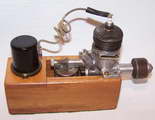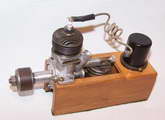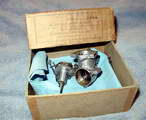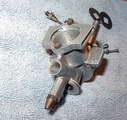Super Scrapper
 |
 |
 |
 |
Click on images to view larger picture.
In Issue 79, Volume 15 of ECJ, Alfred R Dickau provides a history and some personal remembrances of the Scrapper and Super Scrapper. These were products of the Woodbridge Manufacturing Company of Manchester, CT (USA), circa 1945. The author relates his rather sorry experience as a lad of 14 with bad products and a bad refund check. In the article, he estimates that perhaps 2,000 Scrappers were built, but only 12 "Super Scrapper" were built, all being returned due to failures of the head mount. Anderson's Blue Book states that only 700 Scrappers were made and that the Super Scrapper was a prototype only. The AMEE does not give an estimate of Scrapper production and suggests 10-12 for Super Scrapper production, adding that none had timers fitted.
The rarity of the engines and their out-of-the-rut design features made them subjects for the first Motor Boys CAD plan sets. The Scrapper features a demand induction system (aka "clack" valve as it is fully free-floating). The Super Scrapper used a rear drum valve, doubling as the ignition timer cam. Both utilize a ball and socket small-end conrod joint. The construction plans for the Scrapper were included in the first edition of the Motor Boy's Plan Book. While the Super Scrapper set was begun at the same time, it was never fully completed to my satisfaction due of lack of details for the timer, and lack of ideas on how a practical one might be designed!
The problem with timer retention comes about due to the lack of space between the end of the crankcase casting and the fuel tank. It's not hard to dream up a number of ways the timer body could be held in place, and made adjustable, but all would be rather delicate and prone to early failure through a bit of ham-fisted handling—hardly a desirable feature back in the days when competition was fierce and a bad reputation could easily damage sales, not to mention how quickly warranty repairs can eat low profit margins.
The Super Scrapper has a rather sleek, aggressive appearance about it, although the timer is not the only source of potential problems. The cylinder has a blind-bore and complex finning requiring quite a lot of operations to machine, especially around the spark plug boss. It is also thin-walled, secured by only two screws in hard to reach locations leading to a design that would be hard to make, fiddly to assemble, and prone to crash damage; in fact the AR Dickau article states that heads failed destructively at the flange with normal running. Like the clack-valve Scrapper, the piston comprised a thin cast-iron shell with a ball socket riveted into the crown for the conrod. The crown was lightly cone although the combustion chamber was flat roofed. This aspect requires more fiddly assembly operations and very precise location of the crankpin in relation to the cylinder axis in order to ensure the conrod is precisely located on the axis to minimise binding. While not impossible, this requires quite precise machining of the crankcase components and crankshaft; more expense. It's also worth mentioning that neither the crankshaft nor drum valve journals were bushed.

